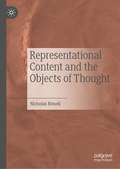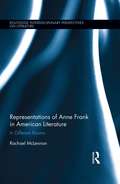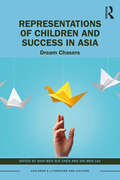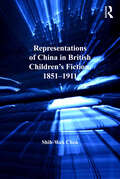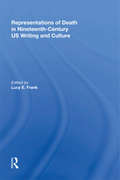- Table View
- List View
Representation Learning for Natural Language Processing
by Maosong Sun Zhiyuan Liu Yankai LinThis open access book provides an overview of the recent advances in representation learning theory, algorithms and applications for natural language processing (NLP). It is divided into three parts. Part I presents the representation learning techniques for multiple language entries, including words, phrases, sentences and documents. Part II then introduces the representation techniques for those objects that are closely related to NLP, including entity-based world knowledge, sememe-based linguistic knowledge, networks, and cross-modal entries. Lastly, Part III provides open resource tools for representation learning techniques, and discusses the remaining challenges and future research directions. The theories and algorithms of representation learning presented can also benefit other related domains such as machine learning, social network analysis, semantic Web, information retrieval, data mining and computational biology. This book is intended for advanced undergraduate and graduate students, post-doctoral fellows, researchers, lecturers, and industrial engineers, as well as anyone interested in representation learning and natural language processing.
The Representation of Genocide in Graphic Novels: Considering the Role of Kitsch (Palgrave Studies in Comics and Graphic Novels)
by Laurike in 't VeldThis book mobilises the concept of kitsch to investigate the tensions around the representation of genocide in international graphic novels that focus on the Holocaust and the genocides in Armenia, Rwanda, and Bosnia. In response to the predominantly negative readings of kitsch as meaningless or inappropriate, this book offers a fresh approach that considers how some of the kitsch strategies employed in these works facilitate an affective interaction with the genocide narrative. These productive strategies include the use of the visual metaphors of the animal and the doll figure and the explicit and excessive depictions of mass violence. The book also analyses where kitsch still produces problems as it critically examines depictions of perpetrators and the visual and verbal representations of sexual violence. Furthermore, it explores how graphic novels employ anti-kitsch strategies to avoid the dangers of excess in dealing with genocide. The Representation of Genocide in Graphic Novels will appeal to those working in comics-graphic novel studies, popular culture studies, and Holocaust and genocide studies.
Representation of Language: Philosophical Issues in a Chomskyan Linguistics
by Georges ReyThis book is a defense of a Chomskyan conception of language against philosophical objectionsthat have been raised against it. It also provides, however, a critical examination of some of the glosses on the theory: the assimilation of it to traditional Rationalism; a supposed conflict between being innate and learned; an unclear ontology and the need of a "representational pretense" with regard to it; and, most crucially, a rejection of Chomsky's eliminativism about the role of intentionality not only in his own theories, but in any serious science at all. This last is a fundamentally important issue for linguistics, psychology, and philosophy that an examination of a theory as rich and promising as a Chomskyan linguistics should help illuminate. The book ends with a discussion of some further issues that Chomsky misleadingly associates with his theory: an anti-realism about ordinary thought and talk, and a dismissal of the mind/body problem(s), towards the solution of some of which his theory in fact makes an important contribution.
Representation of Language: Philosophical Issues in a Chomskyan Linguistics
by Georges ReyThis book is a defense of a Chomskyan conception of language against philosophical objectionsthat have been raised against it. It also provides, however, a critical examination of some of the glosses on the theory: the assimilation of it to traditional Rationalism; a supposed conflict between being innate and learned; an unclear ontology and the need of a "representational pretense" with regard to it; and, most crucially, a rejection of Chomsky's eliminativism about the role of intentionality not only in his own theories, but in any serious science at all. This last is a fundamentally important issue for linguistics, psychology, and philosophy that an examination of a theory as rich and promising as a Chomskyan linguistics should help illuminate. The book ends with a discussion of some further issues that Chomsky misleadingly associates with his theory: an anti-realism about ordinary thought and talk, and a dismissal of the mind/body problem(s), towards the solution of some of which his theory in fact makes an important contribution.
The Representation of Masochism and Queer Desire in Film and Literature
by B. MennelDefining masochism as 'literary perversion', this book probes the productivity of masochistic aesthetics in the literature of Leopold von Sacher-Masoch and contemporary queer films, analysing radical accounts of desire, gender, and sexuality.
The Representation of REFUGEES and MIGRANTS in European National Media Discourses from 2015 to 2017: A Contrastive Approach (Corpus Linguistics) (Linguistik in Empirie und Theorie/Empirical and Theoretical Linguistics)
by Annamária FábiánThough the refugee crisis was discussed in many countries e.g. in Greece, Hungary, Italy and Spain long before 2015, it began to receive cross- European press coverage only after Angela Merkel’s statement ‘Wir schaffen das!’ on the August 30th 2015 This data-based study focuses on, how journalists report on and leading politicians make statements about refugees, migrants and asylum seekers in media and frame these humans after Angela Merkels’ sentence in 2015 until the end of 2017. This volume uses mainly Corpus Linguistics but also Communicative Science for the analysis of labelling strategies and the usage of words, collocations and grammar systems used by journalists and politicians in different European countries in comparison. This empirical volume pictures language specific variation and change of labels. To enable a contrastive study between the press discourses of many European countries, every chapter analyses the data consisting of newspaper articles describing the discourse of a particular country, including discourses of some transit countries around the borders of the Schengen Area of the European Union, which barely have been covered in other studies.
Representation of the British Suffrage Movement (Corpus and Discourse)
by Kat GuptaFocussing on The Times, this monograph uses corpus linguistics to examine how suffrage campaigners' different ideologies were conflated in the newspaper over a crucial time period for the movement - 1908 to 1914, leading up to the Representation of the People Act in 1918. Looking particularly at representations of suffrage campaigners' support of or opposition to military action, Gupta uses a range of methodological approaches drawn from corpus linguistics, discourse analysis and CDA. These include: collocation analysis, examination of consistent significant collocates and van Leeuwen's taxonomy of social actors.The book offers an innovative insight into contemporary public understanding of the suffrage campaign with implications for researchers examining large, complex protest movements.
Representation of the British Suffrage Movement (Corpus and Discourse)
by Kat GuptaFocussing on The Times, this monograph uses corpus linguistics to examine how suffrage campaigners' different ideologies were conflated in the newspaper over a crucial time period for the movement - 1908 to 1914, leading up to the Representation of the People Act in 1918. Looking particularly at representations of suffrage campaigners' support of or opposition to military action, Gupta uses a range of methodological approaches drawn from corpus linguistics, discourse analysis and CDA. These include: collocation analysis, examination of consistent significant collocates and van Leeuwen's taxonomy of social actors.The book offers an innovative insight into contemporary public understanding of the suffrage campaign with implications for researchers examining large, complex protest movements.
Representational Content and the Objects of Thought
by Nicholas RimellThis book defends a novel view of mental representation—of how, as thinkers, we represent the world as being. The book serves as a response to two problems in the philosophy of mind. One is the problem of first-personal, or egocentric, belief: how can we have truly first personal beliefs—beliefs in which we think about ourselves as ourselves—given that beliefs are supposed to be attitudes towards propositions and that propositions are supposed to have their truth values independent of a perspective? The other problem is how we can think about nonexistents (e.g., Santa Claus) given the widespread view that thought essentially involves a relation between a thinker and whatever is being thought about. The standard responses to this puzzle are either to deny that thought is essentially relational or to insist that it is possible to stand in relations to nonexistents. This book offers an error theory to the problem. The responses from this book arise from the same commitment: a commitment to treating talk of propositions—as the things towards which our beliefs are attitudes—as talk of entities that actually exist and that play a constitutive and explanatory role in the activity of thought.
Representations: Doing Asian American Rhetoric
by LuMing Mao Morris YoungAsian American rhetorics, produced through cultural contact between Asian traditions and US English, also comprise a dynamic influence on the cultural conditions and practices within which they move. Though always interesting to linguists and "contact language" scholars, in an increasingly globalized era, these subjects are of interest to scholars in a widening range of disciplines—especially those in rhetoric and writing studies. Mao, Young, and their contributors propose that Asian American discourse should be seen as a spacious form, one that deliberately and selectively incorporates Asian “foreign-ness” into the English of Asian Americans. These authors offer the concept of a dynamic “togetherness-in-difference” as a way to theorize the contact and mutual influence. Chapters here explore a rich diversity of histories, theories, literary texts, and rhetorical practices. Collectively, they move the scholarly discussion toward a more nuanced, better balanced, critically informed representation of the forms of Asian American rhetorics and the cultural work that they do.
Representations of Anne Frank in American Literature: Stories in New Ways (Routledge Interdisciplinary Perspectives on Literature)
by Rachael McLennanThis book explores portrayals of Anne Frank in American literature, where she is often invoked, if problematically, as a means of encouraging readers to think widely about persecution, genocide, and victimisation; often in relation to gender, ethnicity, and race. It shows how literary representations of Anne Frank in America over the past 50 years reflect the continued dominance of the American dramatic adaptations of Frank’s Diary in the 1950s, and argues that authors feel compelled to engage with the problematic elements of these adaptations and their iconic power. At the same time, though, literary representations of Frank are associated with the adaptations; critics often assume that these texts unquestioningly perpetuate the problems with the adaptations. This is not true. This book examines how American authors represent Frank in order to negotiate difficult questions relating to representation of the Holocaust in America, and in order to consider gender, coming of age, and forms of inequality in American culture in various historical moments; and of course, to consider the ways Frank herself is represented in America. This book argues that the most compelling representations of Frank in American literature are alert to their own limitations, and may caution against making Frank a universal symbol of goodness or setting up too easy identifications with her. It will be of great interest to researchers and students of Frank, the Holocaust in American fiction and culture, gender studies, life writing, young adult fiction, and ethics.
Representations of Anne Frank in American Literature: Stories in New Ways (Routledge Interdisciplinary Perspectives on Literature)
by Rachael McLennanThis book explores portrayals of Anne Frank in American literature, where she is often invoked, if problematically, as a means of encouraging readers to think widely about persecution, genocide, and victimisation; often in relation to gender, ethnicity, and race. It shows how literary representations of Anne Frank in America over the past 50 years reflect the continued dominance of the American dramatic adaptations of Frank’s Diary in the 1950s, and argues that authors feel compelled to engage with the problematic elements of these adaptations and their iconic power. At the same time, though, literary representations of Frank are associated with the adaptations; critics often assume that these texts unquestioningly perpetuate the problems with the adaptations. This is not true. This book examines how American authors represent Frank in order to negotiate difficult questions relating to representation of the Holocaust in America, and in order to consider gender, coming of age, and forms of inequality in American culture in various historical moments; and of course, to consider the ways Frank herself is represented in America. This book argues that the most compelling representations of Frank in American literature are alert to their own limitations, and may caution against making Frank a universal symbol of goodness or setting up too easy identifications with her. It will be of great interest to researchers and students of Frank, the Holocaust in American fiction and culture, gender studies, life writing, young adult fiction, and ethics.
Representations of Book Culture in Eighteenth-Century English Imaginative Writing (New Directions in Book History)
by Joanna MaciulewiczThis book is a contribution to the new field of literary studies which is informed by book history and takes interest in the intersection of the ideal and material aspects of literature. It studies the ways eighteenth-century English novels, plays and poems illustrated the changes which the growth of literacy, the proliferation of writing and the emergence of print marketplace made in the social and cultural life of Britain and demonstrated the contingency of the emerging criticism on the technological and economic conditions of book production. The first part focusses on the representation of the tensions created by the emergence of literate society and on the hopes and fears awoken by the expansion of the cultural public sphere caused by the proliferation of print. The second part explores the contribution of literature to the shaping of the roles of authors, readers and patrons in the field of literary production.
Representations of Book Culture in Eighteenth-Century English Imaginative Writing (New Directions in Book History)
by Joanna MaciulewiczThis book is a contribution to the new field of literary studies which is informed by book history and takes interest in the intersection of the ideal and material aspects of literature. It studies the ways eighteenth-century English novels, plays and poems illustrated the changes which the growth of literacy, the proliferation of writing and the emergence of print marketplace made in the social and cultural life of Britain and demonstrated the contingency of the emerging criticism on the technological and economic conditions of book production. The first part focusses on the representation of the tensions created by the emergence of literate society and on the hopes and fears awoken by the expansion of the cultural public sphere caused by the proliferation of print. The second part explores the contribution of literature to the shaping of the roles of authors, readers and patrons in the field of literary production.
Representations of Childhood in American Modernism
by Michelle H. PhillipsThis book documents American modernism’s efforts to disenchant adult and child readers alike of the essentialist view of childhood as redemptive, originary, and universal. For James, Barnes, Du Bois, and Stein, the twentieth century’s move to position the child at the center of the self and society raised concerns about the shrinking value of maturity and prompted a critical response that imagined childhood and children’s narratives in ways virtually antagonistic to both. In this original study, Michelle H. Phillips argues that American modernism’s widespread critique of childhood led to some of the period’s most meaningful and most misunderstood experiments with interiority, narration, and children’s literature.
Representations of Children and Success in Asia: Dream Chasers (Children's Literature and Culture)
by Shih-Wen Sue Chen Sin Wen LauThis edited volume explores how success is conceptualized and represented in texts for young people in Asia. The essays in this collection examine how success for children relates to education, family, gender, race, class, community, and the nation. It answers the following questions: How is success for children represented in literature, cinema, and popular media? In what ways are these images grounded in the historical, political, and cultural contexts in which they are produced and consumed? How does childhood agency influence ideas about success in Asia? Highlighting the similarities and differences in how success is defined for children and young adults in Japan, South Korea, People’s Republic of China, Singapore, Taiwan, Indonesia, Vietnam, and India, this volume argues that success is an important keyword in the literary and cultural study of childhood in Asia.
Representations of Children and Success in Asia: Dream Chasers (Children's Literature and Culture)
by Sue Chen, Shih-Wen and Wen Lau, SinThis edited volume explores how success is conceptualized and represented in texts for young people in Asia. The essays in this collection examine how success for children relates to education, family, gender, race, class, community, and the nation. It answers the following questions: How is success for children represented in literature, cinema, and popular media? In what ways are these images grounded in the historical, political, and cultural contexts in which they are produced and consumed? How does childhood agency influence ideas about success in Asia? Highlighting the similarities and differences in how success is defined for children and young adults in Japan, South Korea, People’s Republic of China, Singapore, Taiwan, Indonesia, Vietnam, and India, this volume argues that success is an important keyword in the literary and cultural study of childhood in Asia.
Representations of China in British Children's Fiction, 1851-1911 (Studies in Childhood, 1700 to the Present)
by Shih-Wen ChenIn her extensively researched exploration of China in British children’s literature, Shih-Wen Chen provides a sustained critique of the reductive dichotomies that have limited insight into the cultural and educative role these fictions played in disseminating ideas and knowledge about China. Chen considers a range of different genres and types of publication-travelogue storybooks, historical novels, adventure stories, and periodicals-to demonstrate the diversity of images of China in the Victorian and Edwardian imagination. Turning a critical eye on popular and prolific writers such as Anne Bowman, William Dalton, Edwin Harcourt Burrage, Bessie Marchant, G.A. Henty, and Charles Gilson, Chen shows how Sino-British relations were influential in the representation of China in children’s literature, challenges the notion that nineteenth-century children’s literature simply parroted the dominant ideologies of the age, and offers insights into how attitudes towards children’s relationship with knowledge changed over the course of the century. Her book provides a fresh context for understanding how China was constructed in the period from 1851 to 1911 and sheds light on British cultural history and the history and uses of children’s literature.
Representations of China in British Children's Fiction, 1851-1911 (Studies in Childhood, 1700 to the Present)
by Shih-Wen ChenIn her extensively researched exploration of China in British children’s literature, Shih-Wen Chen provides a sustained critique of the reductive dichotomies that have limited insight into the cultural and educative role these fictions played in disseminating ideas and knowledge about China. Chen considers a range of different genres and types of publication-travelogue storybooks, historical novels, adventure stories, and periodicals-to demonstrate the diversity of images of China in the Victorian and Edwardian imagination. Turning a critical eye on popular and prolific writers such as Anne Bowman, William Dalton, Edwin Harcourt Burrage, Bessie Marchant, G.A. Henty, and Charles Gilson, Chen shows how Sino-British relations were influential in the representation of China in children’s literature, challenges the notion that nineteenth-century children’s literature simply parroted the dominant ideologies of the age, and offers insights into how attitudes towards children’s relationship with knowledge changed over the course of the century. Her book provides a fresh context for understanding how China was constructed in the period from 1851 to 1911 and sheds light on British cultural history and the history and uses of children’s literature.
Representations of China in Latin American Literature (Liverpool Latin American Studies #29)
by Maria Montt StrabucchiAn Open Access edition of this book is available on the Liverpool University Press website and the OAPEN library as part of the Opening the Future project with COPIM. Representations of China in Latin American Literature (1987-2016) analyses contemporary Latin American novels in which China is the main theme. Using ‘China’ as a multidimensional term, it explores how the novels both highlight and undermine assumptions about China that have shaped Latin America’s understanding of ‘China’ and shows ‘China’ to be a kind of literary/imaginary ‘third’ term which reframes Latin American discourses of alterity. On one level, it argues that these texts play with the way that ‘China’ stands in as a wandering signifier and as a metonym for Asia, a gesture that essentialises it as an unchanging other. On another level, it argues that the novels’ employment of ‘China’ resists essentialist constructions of identity. ‘China’ is thus shown to be serving as a concept which allows for criticism of the construction of fetishized otherness and of the exclusion inherent in essentialist discourses of identity. The book presents and analyses the depiction of an imaginary of China which is arguably performative, but which discloses the tropes and themes which may be both established and subverted, in the novels. Chapter One examines the way in which ‘China’ is represented and constructed in Latin American novels where this country is a setting for their stories. The novels studied in Chapter Two are linked to the presence of Chinese communities in Latin America. The final chapter examines novels whose main theme is travel to contemporary China. Ultimately, in the novels studied in this book ‘China’ serves as a concept through which essentialist notions of identity are critiqued.
Representations of China in Latin American Literature (Liverpool Latin American Studies #29)
by Maria Montt StrabucchiAn Open Access edition of this book is available on the Liverpool University Press website and the OAPEN library as part of the Opening the Future project with COPIM. Representations of China in Latin American Literature (1987-2016) analyses contemporary Latin American novels in which China is the main theme. Using ‘China’ as a multidimensional term, it explores how the novels both highlight and undermine assumptions about China that have shaped Latin America’s understanding of ‘China’ and shows ‘China’ to be a kind of literary/imaginary ‘third’ term which reframes Latin American discourses of alterity. On one level, it argues that these texts play with the way that ‘China’ stands in as a wandering signifier and as a metonym for Asia, a gesture that essentialises it as an unchanging other. On another level, it argues that the novels’ employment of ‘China’ resists essentialist constructions of identity. ‘China’ is thus shown to be serving as a concept which allows for criticism of the construction of fetishized otherness and of the exclusion inherent in essentialist discourses of identity. The book presents and analyses the depiction of an imaginary of China which is arguably performative, but which discloses the tropes and themes which may be both established and subverted, in the novels. Chapter One examines the way in which ‘China’ is represented and constructed in Latin American novels where this country is a setting for their stories. The novels studied in Chapter Two are linked to the presence of Chinese communities in Latin America. The final chapter examines novels whose main theme is travel to contemporary China. Ultimately, in the novels studied in this book ‘China’ serves as a concept through which essentialist notions of identity are critiqued.
Representations of Classical Greece in Theme Parks (IMAGINES – Classical Receptions in the Visual and Performing Arts)
by Filippo Carlà-UhinkTheme park studies is a growing field in social and cultural studies. Nonetheless, until now little attention has been dedicated to the choice of the themes represented in the parks and the strategies of their representation. This is particularly interesting when the theme is a historical one, for example ancient Greece. Which elements of classical Greece find their way into a theme park and how are they chosen and represented? What is the “entertainment” element in ancient Greek history, culture and myth, which allows its presence in commercial structures aiming to people's fun? How does the representation of Greece change against different cultural backgrounds, e.g. in different European countries, in the USA, in China? This book frames a discussion of these representations within the current debates about immersive spaces, uses of history and postmodern aesthetics, and analyses how ancient Greece has been represented and made “enjoyable” in seven different theme parks across the world, providing an original and ground-breaking contribution to theme park studies and classical reception.
Representations of Classical Greece in Theme Parks (IMAGINES – Classical Receptions in the Visual and Performing Arts)
by Filippo Carlà-UhinkTheme park studies is a growing field in social and cultural studies. Nonetheless, until now little attention has been dedicated to the choice of the themes represented in the parks and the strategies of their representation. This is particularly interesting when the theme is a historical one, for example ancient Greece. Which elements of classical Greece find their way into a theme park and how are they chosen and represented? What is the “entertainment” element in ancient Greek history, culture and myth, which allows its presence in commercial structures aiming to people's fun? How does the representation of Greece change against different cultural backgrounds, e.g. in different European countries, in the USA, in China? This book frames a discussion of these representations within the current debates about immersive spaces, uses of history and postmodern aesthetics, and analyses how ancient Greece has been represented and made “enjoyable” in seven different theme parks across the world, providing an original and ground-breaking contribution to theme park studies and classical reception.
Representations of Death in Nineteenth-Century US Writing and Culture
by Lucy FrankFrom the famous deathbed scene of Harriet Beecher Stowe's Little Eva to Mark Twain's parodically morbid poetess Emmeline Grangerford, a preoccupation with human finitude informs the texture of nineteenth-century US writing. This collection traces the vicissitudes of this cultural preoccupation with the subject of death and examines how mortality served paradoxically as a site on which identity and subjectivity were productively rethought. Contributors from North America and the United Kingdom, representing the fields of literature, theatre history, and American studies, analyze the sexual, social, and epistemological boundaries implicit in nineteenth-century America's obsession with death, while also seeking to give a voice to the strategies by which these boundaries were interrogated and displaced. Topics include race- and gender-based investigations into the textual representation of death, imaginative constructions and re-constructions of social practice with regard to loss and memorialisation, and literary re-conceptualisations of death forced by personal and national trauma.
Representations of Death in Nineteenth-Century US Writing and Culture
by Lucy E. FrankFrom the famous deathbed scene of Harriet Beecher Stowe's Little Eva to Mark Twain's parodically morbid poetess Emmeline Grangerford, a preoccupation with human finitude informs the texture of nineteenth-century US writing. This collection traces the vicissitudes of this cultural preoccupation with the subject of death and examines how mortality served paradoxically as a site on which identity and subjectivity were productively rethought. Contributors from North America and the United Kingdom, representing the fields of literature, theatre history, and American studies, analyze the sexual, social, and epistemological boundaries implicit in nineteenth-century America's obsession with death, while also seeking to give a voice to the strategies by which these boundaries were interrogated and displaced. Topics include race- and gender-based investigations into the textual representation of death, imaginative constructions and re-constructions of social practice with regard to loss and memorialisation, and literary re-conceptualisations of death forced by personal and national trauma.






